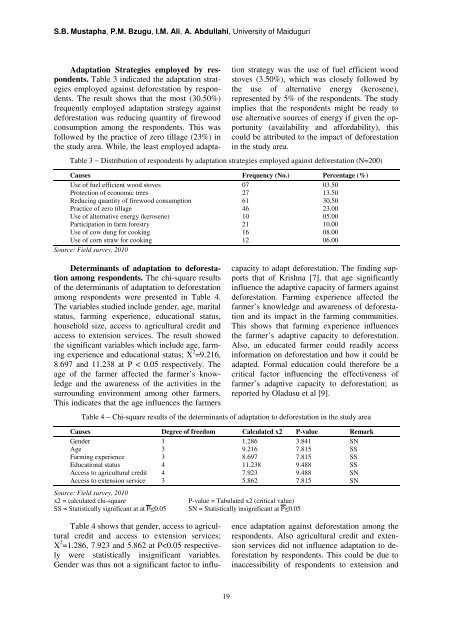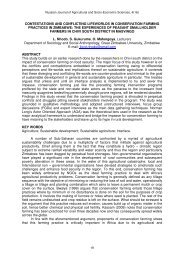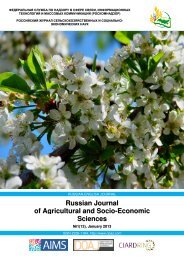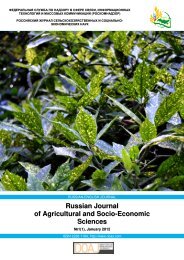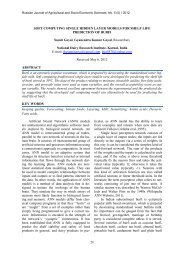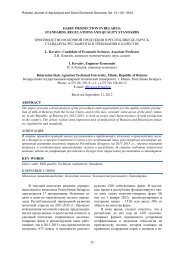Russian Journal of Agricultural and Socio-Economic Sciences ...
Russian Journal of Agricultural and Socio-Economic Sciences ...
Russian Journal of Agricultural and Socio-Economic Sciences ...
Create successful ePaper yourself
Turn your PDF publications into a flip-book with our unique Google optimized e-Paper software.
S.B. Mustapha, P.M. Bzugu, I.M. Ali, A. Abdullahi, University <strong>of</strong> MaiduguriAdaptation Strategies employed by respondents.Table 3 indicated the adaptation strategiesemployed against deforestation by respondents.The result shows that the most (30.50%)frequently employed adaptation strategy againstdeforestation was reducing quantity <strong>of</strong> firewoodconsumption among the respondents. This wasfollowed by the practice <strong>of</strong> zero tillage (23%) inthe study area. While, the least employed adaptationstrategy was the use <strong>of</strong> fuel efficient woodstoves (3.50%), which was closely followed bythe use <strong>of</strong> alternative energy (kerosene),represented by 5% <strong>of</strong> the respondents. The studyimplies that the respondents might be ready touse alternative sources <strong>of</strong> energy if given the opportunity(availability <strong>and</strong> affordability), thiscould be attributed to the impact <strong>of</strong> deforestationin the study area.Table 3 − Distribution <strong>of</strong> respondents by adaptation strategies employed against deforestation (N=200)Causes Frequency (No.) Percentage (%)Use <strong>of</strong> fuel efficient wood stoves 07 03.50Protection <strong>of</strong> economic trees 27 13.50Reducing quantity <strong>of</strong> firewood consumption 61 30.50Practice <strong>of</strong> zero tillage 46 23.00Use <strong>of</strong> alternative energy (kerosene) 10 05.00Participation in farm forestry 21 10.00Use <strong>of</strong> cow dung for cooking 16 08.00Use <strong>of</strong> corn straw for cooking 12 06.00Source: Field survey, 2010Determinants <strong>of</strong> adaptation to deforestationamong respondents. The chi-square results<strong>of</strong> the determinants <strong>of</strong> adaptation to deforestationamong respondents were presented in Table 4.The variables studied include gender, age, maritalstatus, farming experience, educational status,household size, access to agricultural credit <strong>and</strong>access to extension services. The result showedthe significant variables which include age, farmingexperience <strong>and</strong> educational status; X 2 =9.216,8.697 <strong>and</strong> 11.238 at P < 0.05 respectively. Theage <strong>of</strong> the farmer affected the farmer’s knowledge<strong>and</strong> the awareness <strong>of</strong> the activities in thesurrounding environment among other farmers.This indicates that the age influences the farmerscapacity to adapt deforestation. The finding supportsthat <strong>of</strong> Krishna [7], that age significantlyinfluence the adaptive capacity <strong>of</strong> farmers againstdeforestation. Farming experience affected thefarmer’s knowledge <strong>and</strong> awareness <strong>of</strong> deforestation<strong>and</strong> its impact in the farming communities.This shows that farming experience influencesthe farmer’s adaptive capacity to deforestation.Also, an educated farmer could readily accessinformation on deforestation <strong>and</strong> how it could beadapted. Formal education could therefore be acritical factor influencing the effectiveness <strong>of</strong>farmer’s adaptive capacity to deforestation; asreported by Oladusu et al [9].Table 4 − Chi-square results <strong>of</strong> the determinants <strong>of</strong> adaptation to deforestation in the study areaCauses Degree <strong>of</strong> freedom Calculated x2 P-value RemarkGender 1 1.286 3.841 SNAge 3 9.216 7.815 SSFarming experience 3 8.697 7.815 SSEducational status 4 11.238 9.488 SSAccess to agricultural credit 4 7.923 9.488 SNAccess to extension service 3 5.862 7.815 SNSource: Field survey, 2010x2 = calculated chi-squareSS = Statistically significant at at P


